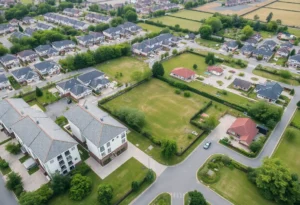Fairview Developmental Center Housing Plan: Balancing Growth and Community in Costa Mesa
As the Chief Marketing Officer for a major Digital Marketing Company in the US, we work with developers and Real Estate Agencies all the time. So, we are sensitive to the incredible interest that the housing affordability issue creates in the communities we serve. In Costa Mesa, the proposed housing plan for the nearly 100-acre Fairview Developmental Center has ignited passionate debate. This former state-run facility could transform into a neighborhood for 10,232 new residents, but with only 7.9 acres of open space, the plan raises critical questions about density, affordability, and the city’s future. As a marketing professional, I see the need for clear communication to bridge divides and ensure all voices are heard in this pivotal moment.
The Fairview Developmental Center Housing Plan
The Fairview Developmental Center, closed in 2015, is one of Costa Mesa’s largest undeveloped parcels. The proposed housing plan, under review in June 2025, envisions a mixed-use development with thousands of residential units, including some affordable housing, to meet California’s Regional Housing Needs Allocation (RHNA) mandates. However, the plan’s scale—potentially adding 10,232 residents—and limited open space (7.9 acres) have sparked concerns about traffic, infrastructure strain, and loss of the city’s suburban character. The debate reflects broader tensions in California’s housing crisis, balancing growth with community identity.
Perspectives of Interested Parties
Real Estate Agents
Real estate agents in Costa Mesa see the Fairview plan as a double-edged sword. On one hand, new housing could attract diverse buyers—young professionals, families, and retirees—easing inventory shortages in a market where median home prices exceed $1.2 million. Agents advocate for mixed-income units to broaden their client base, emphasizing the need for affordable options to retain service workers and military families. On the other hand, they worry that high-density development could depress property values in nearby single-family neighborhoods, a concern echoed by their clients. Agents stress that transparent marketing and community engagement are vital to align the project with Costa Mesa’s values.
Developers
Developers view the Fairview site as a rare opportunity to address Costa Mesa’s housing shortage while meeting state mandates. They propose a mix of market-rate and affordable units, alongside commercial spaces, to create a vibrant community. However, the plan’s high density is driven by land costs and regulatory pressures, making low-cost housing challenging without subsidies. Developers support state efforts, like Assembly Bill 609, to streamline approvals by easing California Environmental Quality Act (CEQA) requirements, which often delay projects. They argue that infrastructure upgrades, like roads and utilities, can mitigate impacts, but need city and state funding to succeed.
Government and Regulatory Bodies
The City of Costa Mesa faces intense pressure from California’s Department of Housing and Community Development (HCD) to meet RHNA targets, requiring thousands of new units by 2029, including affordable housing. The Fairview plan is a cornerstone of compliance, but the city risks sanctions, like the Builder’s Remedy, if it fails to act. State officials, backed by Governor Newsom’s $321 billion budget, push CEQA reforms to expedite housing, but local leaders worry about losing control over design and density. Regulatory bodies, like the Southern California Association of Governments (SCAG), emphasize equitable housing distribution, complicating negotiations with residents who demand more open space and less density.
Greater Costa Mesa Community
Costa Mesa’s residents are sharply divided over the Fairview plan. Long-time homeowners, particularly in suburban neighborhoods, oppose the high-density proposal, citing increased traffic, school overcrowding, and loss of green space as threats to their quality of life. Groups like Costa Mesa First have rallied against the plan, arguing that 7.9 acres of open space is inadequate for 10,232 new residents. Conversely, younger residents, renters, and community advocates support the project, emphasizing the need for affordable housing to keep Costa Mesa accessible to teachers, firefighters, and service workers. The debate has fueled calls for more transparent city planning and community input.
Social Media Buzz
X posts capture the fervor surrounding the Fairview plan. On June 27, 2025, a local advocacy group posted about a City Council meeting discussing the proposal, highlighting resident protests over the plan’s density and limited open space. The post drew heated replies, with some users defending the need for affordable housing and others decrying ‘overdevelopment’ that could ‘ruin Costa Mesa’s charm.’ Another post from a real estate professional emphasized the project’s potential to ease market pressures, but faced pushback from residents prioritizing suburban aesthetics. Hashtags like #CostaMesaHousing and #FairviewDevelopment are amplifying the conversation, reflecting a community wrestling with change.
The Path Forward
The Fairview Developmental Center housing plan is a defining moment for Costa Mesa. Drawing on our expertise in digital marketing, we see clear, compassionate communication as key to uniting stakeholders—real estate agents, developers, city officials, and residents. The city must balance state mandates with community concerns, investing in infrastructure and affordable units while preserving Costa Mesa’s character. By fostering open dialogue and creative solutions, like public-private partnerships or enhanced open spaces, Costa Mesa can turn this challenge into an opportunity for inclusive growth.
Frequently Asked Questions (FAQ)
| Question | Answer | Relevant Parties |
|---|---|---|
| What is the Fairview housing plan? | The plan proposes thousands of residential units, including affordable housing, on the 100-acre Fairview Developmental Center site, potentially adding 10,232 residents with 7.9 acres of open space. | All Parties |
| Why are residents opposing the plan? | Many residents fear high density will increase traffic, strain schools, and reduce green space, threatening Costa Mesa’s suburban character. | Greater Costa Mesa Community |
| How do developers justify the project? | Developers argue it meets state housing mandates, addresses shortages, and can include affordable units, though high costs require subsidies or regulatory relief. | Developers, Government and Regulatory Bodies |
| What role do state mandates play? | California’s RHNA mandates require Costa Mesa to plan for thousands of new units by 2029, with HCD enforcing compliance to avoid sanctions. | Government and Regulatory Bodies, City of Costa Mesa |
| How can real estate agents contribute? | Agents advocate for mixed-income housing and transparent marketing to align the project with community needs and attract diverse buyers. | Real Estate Agents, Greater Costa Mesa Community |
| What is CEQA reform, and why is it relevant? | CEQA reform, like Assembly Bill 609, aims to streamline housing approvals by reducing environmental review barriers, but raises concerns about oversight. | Developers, Government and Regulatory Bodies |
Author: Todd Hunnicutt
Todd Hunnicutt is a dynamic media personality, entrepreneur, coach, and Chief Marketing Officer at Real Internet Sales. Renowned for his technology expertise, he's been featured in the New York Times, National Geographic, and major news outlets. As a nationally syndicated technology writer, Todd is a sought-after voice in marketing, ai, entrepreneurship, and economics, frequently interviewed by industry publications. A proud South Carolina native, he cherishes outdoor adventures, BBQ, Tuesday family dinners, and Sunday church services. A passionate baseball fan, Todd enjoys games alongside his wife, Elizabeth, whose umpire-call critiques rival instant replay. With an extensive background, he's collaborated with Fortune 500 companies, nonprofit startups, and political campaigns. A serial entrepreneur, Todd thrives on innovative ideas and loves hearing a compelling pitch!




